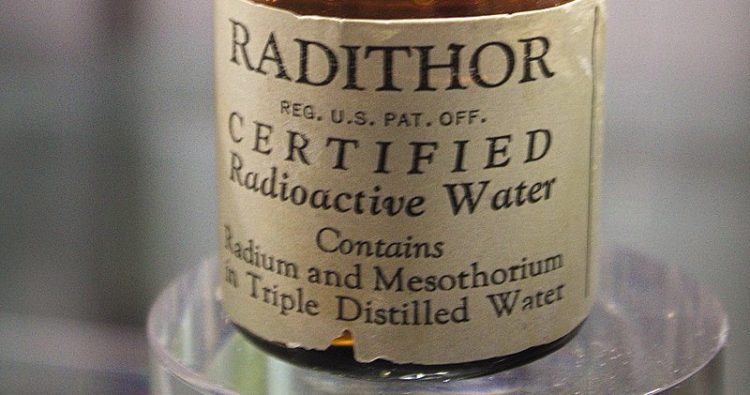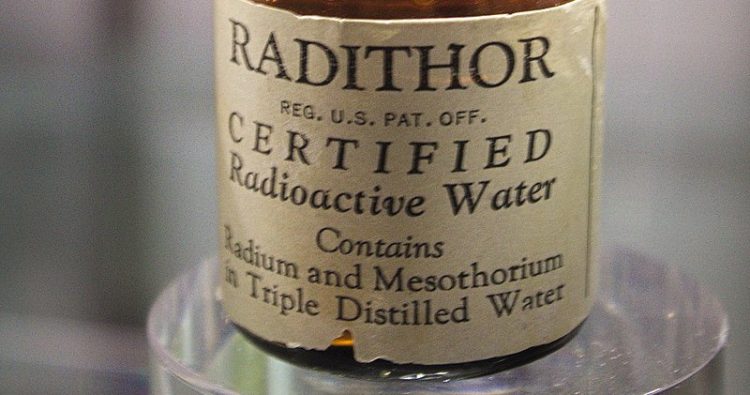It’s hard to believe, but there was once a time when the rich and powerful spent small fortunes on radium-infused distilled water advertised as a cure for a variety of illnesses.
Knowing what we know now about radioactive elements and their effects on the human body, most of us wouldn’t dare touch, let alone drink, a bottle of radium-containing water, but at the beginning of the twentieth century, the so-called “remedy” was all the rage among wealthy socialites. Radithor and other radioactive elixirs were sold as harmless remedies that could combat fatigue, and cure all sorts of conditions, from cancers to impotence. Unfortunately, in reality, they slowly killed the very people they were supposed to heal.

Radithor, which was distilled water containing two radioactive substances, radium and mesothorium, is probably the most famous example of radioactive quackery, most likely because it’s also the only one that can be unambiguously linked to someone’s death. It was sold in small 2 oz bottles and was guaranteed to contain at least 1 microcurie each of Ra-226 and Ra-228.
The manufacturer of Radithor, Bailey Radium Laboratories of East Orange, New Jersey claimed that the expensive tonic gave users a boost of energy and cured dozens of illnesses, including anorexia, hysteria, insomnia. That turned out to be completely false, as the gruesome fate of Radithor most fervent consumer so clearly shows.
Eben Byers, a wealthy American socialite and industrialist, started consuming Radithor at the suggestion of his physician. He had injured his arm on a party train following a Harvard-Yale football game, and he was prescribed Radithor to help with the healing process. In December of 1927, he started drinking about three bottles of the radium-infused distilled water every day and continued to do so for the next couple of years.
Convinced that the Radithor deserved credit for his energy and general wellbeing, Eben Byers couldn’t praise the tonic enough. He sent cases of it to friends and business associates, made sure his girlfriends had it on hand at all times, and even fed it to his racehorses. It is believed that he consumed a whopping 1,400 bottles of Radithor until 1930, when his teeth started falling out.
Eben Byers was in his 50s when the radioactive “energy drink” started taking a toll on his body. It started with his teeth, but that was only the beginning of the end. In 1931, when Robert Hiner Winn, an attorney for the Federal Trade Commission, was sent to interview Byers as part of building a case against the maker of Radithor, he was horrified by the businessman’s condition.
According to Winn’s report, when Eben Byers opened the door of his mansion to welcome him inside, his entire lower jaw and chin were gone, rotted away by radium poisoning. The 51-year-old only had two teeth sticking out of a bone fragment below his nose, and even had holes in his skull exposing his brain.
“A more gruesome experience in a more gorgeous setting would be hard to imagine,” Winn wrote in a 1932 edition of Time Magazine. “Young in years and mentally alert, he could hardly speak. His head was swathed in bandages. He had undergone two successive operations in which his whole upper jaw, excepting two front teeth, and most of his lower jaw had been removed. All the remaining bone tissue of his body was slowly disintegrating, and holes were actually forming in his skull.”
Eben Byers died in 1932, and it was his death that signaled the beginning of the end for Radithor. The industrialist’s own account about the tonic weighed heavily against Bailey Radium Laboratories, and a subsequent lawsuit by the Federal Trade Commission was the final nail in the coffin. Despite the setbacks, Radithor still had its share of supporters, even among medical professionals, but the “cease and desist” order issued by the authorities thankfully put an end to its production as a “healthy” tonic.
Radithor was manufactured from 1918 to 1928, and, apart from Eben Byers’ death, the extent of the damage it did among consumers is largely unknown. Experts believe that the fact that it was an expensive cure-all limited the damage it could have done, as only the wealthy could afford to consume it in large quantities.
When Eben Byers died, he was put to rest in a lead-lined coffin, to block the radiation being released from his bones, and in 1965, when an MIT scientist exhumed his remains to measure how radioactive they were, he was surprised by the findings.
Robley Evans, an expert at measuring and mathematically modeling radioactivity in the human body, estimated that Byers bones had a radioactivity of about 100,000 becquerels when he was buried, and since Radium has a half-life of 1,600 years, the scientist estimated that the exhumed remains would have the same level of radioactivity as before. Only the skeletal remains actually had a total of 225,000 becquerels…
The reason for Evan’s massive error in radioactivity estimation has two plausible explanations, withe Radium’s affinity for bone had been grossly understated, or Byers had consumed much more Radithor than previously believed. The businessman’s remains were resealed in the lead-lined coffin, where they remain to this day, as radioactive as ever.
So yeah, if you thought modern energy drinks were bad, just remember there was once a time when people drank radium-infused distilled water for an energy boost.













